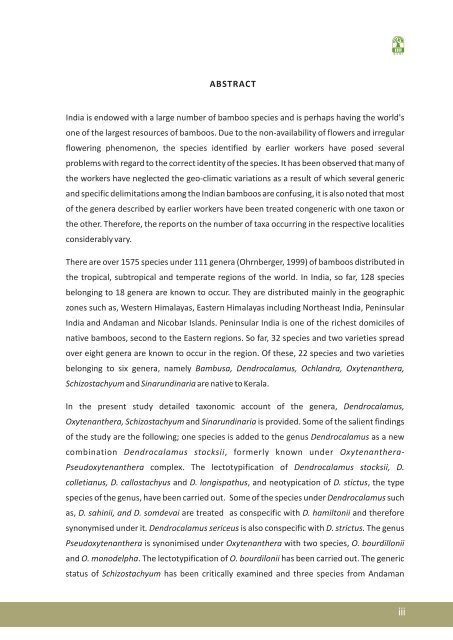Final report bamboo revisionary - Kerala Forest Research Institute
Final report bamboo revisionary - Kerala Forest Research Institute
Final report bamboo revisionary - Kerala Forest Research Institute
Create successful ePaper yourself
Turn your PDF publications into a flip-book with our unique Google optimized e-Paper software.
K F R I<br />
ABSTRACT<br />
India is endowed with a large number of <strong>bamboo</strong> species and is perhaps having the world's<br />
one of the largest resources of <strong>bamboo</strong>s. Due to the non-availability of flowers and irregular<br />
flowering phenomenon, the species identified by earlier workers have posed several<br />
problems with regard to the correct identity of the species. It has been observed that many of<br />
the workers have neglected the geo-climatic variations as a result of which several generic<br />
and specific delimitations among the Indian <strong>bamboo</strong>s are confusing, it is also noted that most<br />
of the genera described by earlier workers have been treated congeneric with one taxon or<br />
the other. Therefore, the <strong>report</strong>s on the number of taxa occurring in the respective localities<br />
considerably vary.<br />
There are over 1575 species under 111 genera (Ohrnberger, 1999) of <strong>bamboo</strong>s distributed in<br />
the tropical, subtropical and temperate regions of the world. In India, so far, 128 species<br />
belonging to 18 genera are known to occur. They are distributed mainly in the geographic<br />
zones such as, Western Himalayas, Eastern Himalayas including Northeast India, Peninsular<br />
India and Andaman and Nicobar Islands. Peninsular India is one of the richest domiciles of<br />
native <strong>bamboo</strong>s, second to the Eastern regions. So far, 32 species and two varieties spread<br />
over eight genera are known to occur in the region. Of these, 22 species and two varieties<br />
belonging to six genera, namely Bambusa, Dendrocalamus, Ochlandra, Oxytenanthera,<br />
Schizostachyum and Sinarundinaria are native to <strong>Kerala</strong>.<br />
In the present study detailed taxonomic account of the genera, Dendrocalamus,<br />
Oxytenanthera, Schizostachyum and Sinarundinaria is provided. Some of the salient findings<br />
of the study are the following; one species is added to the genus Dendrocalamus as a new<br />
combination Dendrocalamus stocksii, formerly known under Oxytenanthera-<br />
Pseudoxytenanthera complex. The lectotypification of Dendrocalamus stocksii, D.<br />
colletianus, D. callostachyus and D. longispathus, and neotypication of D. stictus, the type<br />
species of the genus, have been carried out. Some of the species under Dendrocalamus such<br />
as, D. sahinii, and D. somdevai are treated as conspecific with D. hamiltonii and therefore<br />
synonymised under it. Dendrocalamus sericeus is also conspecific with D. strictus. The genus<br />
Pseudoxytenanthera is synonimised under Oxytenanthera with two species, O. bourdillonii<br />
and O. monodelpha. The lectotypification of O. bourdilonii has been carried out. The generic<br />
status of Schizostachyum has been critically examined and three species from Andaman<br />
iii

















